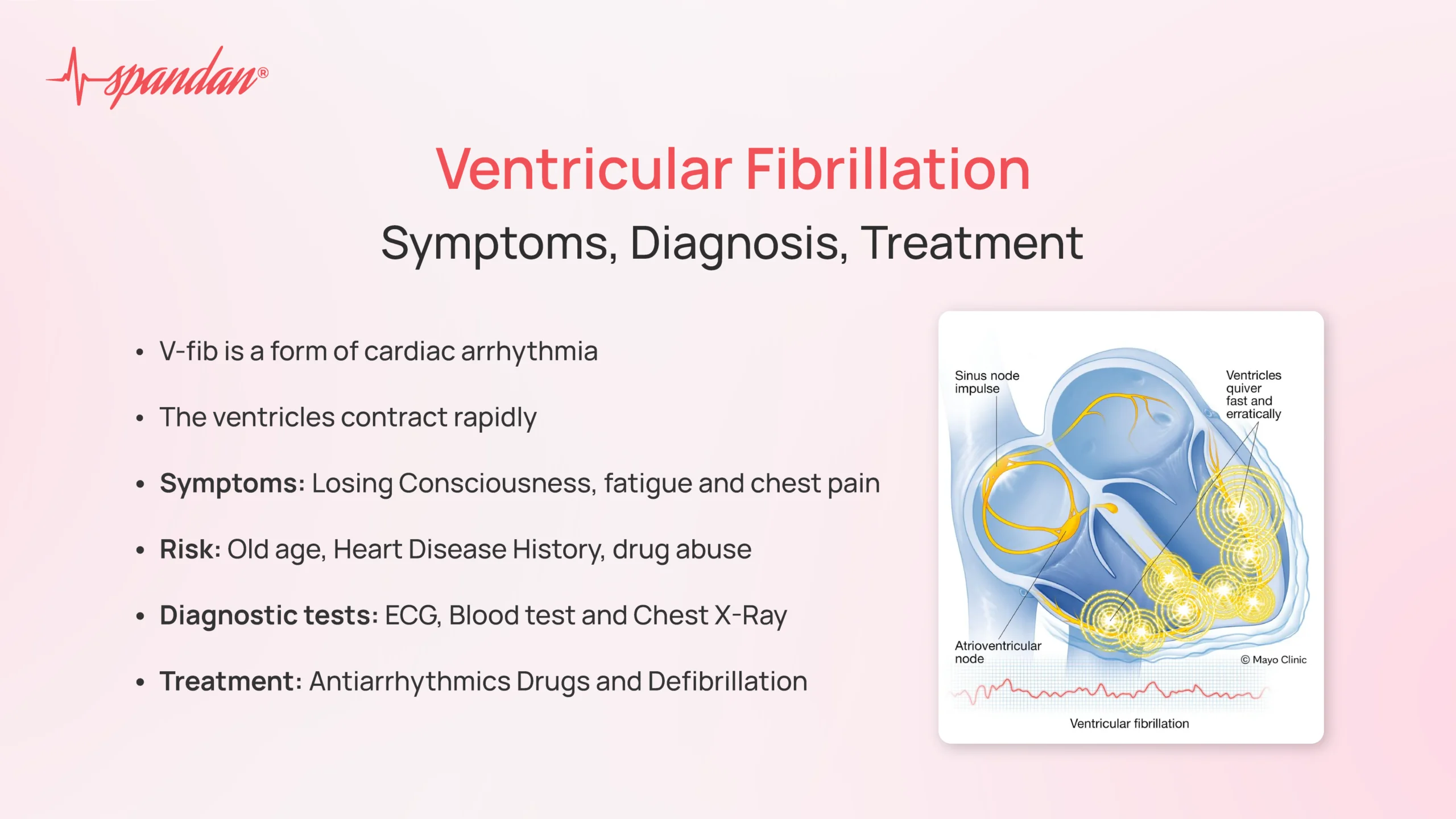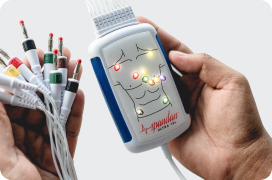
Related Article
Author:- Dr Mansi
Table of Contents
Ventricular fibrillation (V-fib) is a form of cardiac arrhythmia characterized by an irregular heart rhythm. During ventricular fibrillation, the ventricles contract rapidly and in an irregular manner. As a result, the heart fails to circulate blood throughout the body. When blood circulation stops for this reason, one generally has only a few seconds before losing consciousness. This is known as Cardiac arrest, usually fatal within minutes without immediate medical attention.
Ventricular fibrillation originates in the ventricle. This happens when electrical signals signaling your heart muscle to pump blood make your ventricles quiver (fibrillate). The quivering indicates that your heart fails to circulate blood to the rest of your body.
Symptoms of Ventricular Fibrillation
There are many symptoms of ventricular fibrillation. It can manifest in the following ways:
- Loss of Consciousness: A sudden inability to remain awake and aware of one’s surroundings, often due to a lack of oxygen to the brain.
- Shortness of Breath: Difficulty or discomfort in breathing, often described as feeling like you can’t get enough air.
- Fatigue: A feeling of extreme tiredness or lack of energy, often not relieved by rest.
- Palpitation: The sensation of a rapid, fluttering, or pounding heartbeat that may be noticeable in the chest, throat, or neck.
- Dizziness: A sensation of lightheadedness, unsteadiness, or feeling faint, often leading to a loss of balance.
- Chest Pain: A discomfort or pain in the chest area, which may be sharp, dull, or pressure-like and could indicate a heart-related issue.
- Irregular Heartbeat: An abnormal rhythm or rate of the heartbeat, also known as arrhythmia, which may feel like a skipped beat or a fast, slow, or erratic rhythm.
- Fatigue (repeated): Extreme tiredness or exhaustion, often persisting despite adequate rest.
Who is at Risk?
This heart arrhythmia affects a number of people. Some of the individuals likely affected by ventricular fibrillation are as follows:
- Old age raises the risk of heart disease and arrhythmias.
- Individuals with a history of ventricular fibrillation or other arrhythmias.
- People having a history of heart disease: Conditions such as coronary artery disease, myocardial infarction, and heart failure raise the risk.
- Individuals who have undergone major heart surgery may experience arrhythmias, including Ventricular fibrillation
- Those having inherited heart problems including long QT syndrome, Brugada syndrome, or hypertrophic cardiomyopathy.
- Patients with a history of serious electrolyte imbalances: Low amounts of potassium or magnesium can cause ventricular fibrillation.
- People with a history of drug abuse: Cocaine, methamphetamines, and other stimulants can trigger ventricular fibrillation.
- Patients who have received a strong electric shock may experience disruptions in the electrical activity of the heart.
How is Ventricular fibrillation Diagnosed?
Diagnosing ventricular fibrillation requires various tests to evaluate heart function and identify irregularities. These assessments are crucial for understanding the underlying causes and severity of the condition, which guides effective treatment and management.Ventricular fibrillation can be diagnosed by a number of tests and screenings:
1. Electrocardiogram (ECG)
This fast and painless investigation examines the electrical activity of the heart. Electrodes are applied to the chest, sometimes on the arms and legs. Wires link the electrodes to a computer, which shows the test findings. An electrocardiogram (ECG) can determine whether the heart is beating too quickly or too slowly. The ECG will show a heart rate of 300 to 400 beats per minute.
2. Blood tests
Electrolyte levels (potassium and magnesium) may be measured, as abnormalities can cause arrhythmias. Cardiac enzyme testing can detect signs of cardiac damage (for example, following a heart attack), which is a common cause of V-fib.
3. Angiogram
A long, thin tube called a catheter is placed into a blood vessel, usually in the groin or wrist, and moved towards the heart. A special dye is then sent through the catheter to the heart’s arteries. This dye makes the arteries more visible on X-ray images and videos.
4. Chest X-ray
A chest X-ray provides an image of the chest that helps to show the size and shape of the heart and its blood vessels.
Treatment of Ventricular Fibillation
Proper treatment for ventricular fibrillation is essential to restore normal heart rhythm and avoid severe complications. This approach usually involves a combination of medications, defibrillation, and surgical procedures, customized based on the individual’s specific condition and underlying issues.
1. Antiarrhythmics Drugs
- These medications aid in keeping the heart’s rhythm steady.
- Lidocaine: Frequently used to regulate irregular cardiac rhythms in emergency situations.
- Amiodarone: V-fib and other dangerous arrhythmias are managed and prevented using this medication.
- Epinephrine: Usually given to patients experiencing cardiac arrest, particularly those with V-fib, in order to stimulate the heart and improve the likelihood of a successful defibrillation.
- Magnesium sulphate: This is occasionally used, particularly when the arrhythmia is caused by underlying conditions like a magnesium deficit.
2. Defibrillation
It is also known as cardioversion, which involves using an automated external defibrillator (AED) to deliver shocks through the chest to the heart. This treatment can help restore a regular heart rhythm. When an AED is available, apply it and follow the instructions provided
3. Surgical Treatment
- Ventricular fibrillation (V-fib), may be treated surgically in numerous ways. A device placed beneath the skin called an Implantable Cardioverter Defibrillator (ICD) monitors the heart and shocks it if V-fib happens.
- Catheter Ablation during this aberrant cardiac tissue that causes arrhythmias is destroyed with a catheter.
- Coronary Artery Bypass Grafting (CABG) may be performed to bypass blocked arteries if V-fib is due to coronary artery disease. Surgical repair of heart structural issues, such as valve replacements or repairs, may also be necessary.
In conclusion, ventricular fibrillation (V-fib) is a severe arrhythmia belonging to a distinct arrhythmia classification that disrupts the heart’s ability to pump blood effectively, posing a risk of sudden cardiac arrest. Timely recognition of symptoms like loss of consciousness and chest pain is vital. Treatment typically involves immediate defibrillation, along with medications and possibly surgical interventions like ICD implantation or coronary bypass. Prompt action and advances in treatment are key to improving outcomes for those affected by ventricular fibrillation (V-fib).




